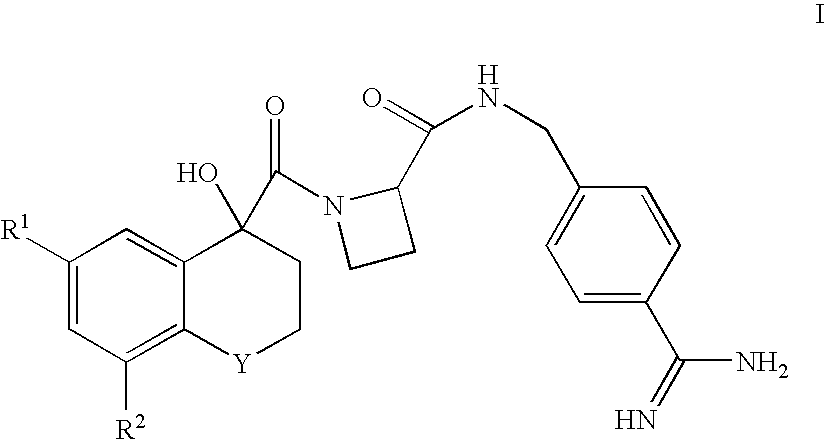Thiochromane derivatives and their use as thrombin inhibitors
a technology of thiochromane derivatives and thromboembolic diseases, which is applied in the direction of biocide, drug composition, extracellular fluid disorder, etc., can solve the problems of thromboembolic diseases, the need for protecting groups, and the need for negate or render necessary
- Summary
- Abstract
- Description
- Claims
- Application Information
AI Technical Summary
Benefits of technology
Problems solved by technology
Method used
Image
Examples
example 1
(R)-6-Chloro-4-hydroxy-8-methoxy-1,1-dioxothiochromane-4-yl-C(O)-Aze-Pab
(i) 3-(4-Chloro-2-methoxyphenylthio)propanoic Acid, Ethyl Ester
4-Chloro-2-methoxythiophenol (5.78 g, 33 mmol), triethylamine (5.0 mL, 36 mmol) and ethyl 3-bromopropanoate (4.6 mL, 36 mmol) were dissolved in ethyl acetate (50 mL) and refluxed for 2 h. Water was added and the liquid phases were separated. The aqueous phase was extracted two times with ethyl acetate. The combined organic fractions were washed with 1 M aq. HCl and then concentrated in vacuo. Purification by flash chromatography (SiO.sub.2 ; heptane: dichloromethane (1:1, 0:1)) afforded the sub-title compound as a yellow solid. Yield: 3.0 g (30%). Estimated purity: 75% (NMR).
Bis(4-chloro-2-methoxyphenyl) disulfide (1.7 g, 4.9 mmol) was also isolated (vide supra). This material was dissolved in THF:EtOH (80 mL of 1:1) and stirred under N.sub.2 (g). A solution of sodium borohydride (0.38 g, 10 mmol) in 2 M aq. NaOH (2 mL) and water (10 mL) was added. T...
example 2
(R)-6,8-Dichloro-4-hydroxy-1,1-dioxothiochromane-4-yl-C(O)-Aze-Pab
(i) 3-(2,4-Dichlorophenylthio)propanoic Acid, Ethyl Ester
2,4-Dichlorothiophenol (5.04 g, 28.2 mmol), caesium carbonate (10.1 g, 31 mmol) and ethyl 3-bromopropanoate (4.2 mL, 33 mmol) in acetone (100 mL) were refluxed overnight under N.sub.2 (g). After filtration and concentration under reduced pressure, the residue was partitioned between dichloromethane and water. After separation, the aqueous phase was extracted once with dichloromethane. Drying and removal of the solvent in vacuo afforded a liquid residue that contained .about.30% (HPLC) of unreacted 2,4-dichlorothiophenol. The mixture was refluxed again with caesium carbonate (4.7 g) and ethyl 3-bromopropanoate (2 mL) in acetonitrile (100 mL) under N.sub.2 (g) for 2 h. After filtration and concentration under reduced pressure, the residue was dissolved in diethyl ether and washed with 2 M aq. sodium hydroxide and water. Drying and removal of the solvent in vacuo a...
example 3
(R)-6-Chloro-4-hydroxy-1,1-dioxothiochromane-4-yl-C(O)-Aze-Pab
(i) 6-Chloro-4-hydroxythiochromane-4-yl-carboxylic Acid, Methyl Ester
The sub-title compound was prepared according to the method of C. F. Bigge et al. in J. Med. Chem., (1993), 36, 1977 from 6-chloro-4-thiochromanone (1.74 g, 8.76 mmol) using methanol instead of ethanol.
Yield: 0.625 g (28%). .sup.1 H NMR (500 MHz; CDCl.sub.3) .delta. 7.07-7.15 (several peaks, 3H), 3.93 (s, 1H), 3.93 (s, 3H), 3.23 (ddd, 1H), 2.99 (ddd, 1H), 2.42 (ddd, 1H), 2.34 (ddd, 1H).
(ii) 6-Chloro-4-hydroxythiochromane-4-yl-carboxamide
The sub-title compound was obtained as the main product in the previous step and isolated using reversed phase HPLC (acetonitrile: 0.1 M aq. ammonium acetate).
Yield: 1.49 g (70%). .sup.1 H NMR (500 MHz; CDCl.sub.3) .delta. 7.35 (d, 1H), 7.15 (dd, 1H), 7.09 (d, 1H), 6.32 (bs, 1H), 5.90 (bs, 1H), 3.86 (bs, 1H), 3.19 (ddd, 1H), 3.03 (ddd, 1H), 2.40 (ddd, 1H), 2.30 (ddd, 1H).
(iii) 6-Chloro-4-hydroxythiochromane-4-yl-carboxyli...
PUM
| Property | Measurement | Unit |
|---|---|---|
| temperature | aaaaa | aaaaa |
| temperature | aaaaa | aaaaa |
| time | aaaaa | aaaaa |
Abstract
Description
Claims
Application Information
 Login to View More
Login to View More - R&D
- Intellectual Property
- Life Sciences
- Materials
- Tech Scout
- Unparalleled Data Quality
- Higher Quality Content
- 60% Fewer Hallucinations
Browse by: Latest US Patents, China's latest patents, Technical Efficacy Thesaurus, Application Domain, Technology Topic, Popular Technical Reports.
© 2025 PatSnap. All rights reserved.Legal|Privacy policy|Modern Slavery Act Transparency Statement|Sitemap|About US| Contact US: help@patsnap.com



